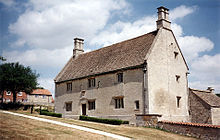Woolsthorpe-by-Colsterworth
Coordinates: 52 ° 48 ′ 36 ″ N , 0 ° 37 ′ 59 ″ W.
Woolsthorpe-by-Colsterworth is a hamlet in the parish of Colsterworth in the South Kesteven district of Lincolnshire, England . The place is known as the birthplace of Isaac Newton .
Woolsthorpe-by-Colsterworth is 170 kilometers north of London and one kilometer west of the A1 , which is an important north-south link in the United Kingdom.
Woolsthorpe Manor
Woolsthorpe Manor, Newton's birthplace, is a small late 16th or early 17th century limestone manor house. It is owned by the National Trust and is open to the public. Newton was there on December 25, 1642 jul. / 4th January 1643 greg. born. He came back there during the Great Plague of London from 1665 to 1667, in what he called ' Annus mirabilis ' because of his findings , and also carried out experiments here. It is assumed that the observation of an apple on the apple tree, possibly also the fall of the apple from the tree, in the garden of Woolsthorpe Manor brought him to Newton's law of gravitation . The apple legend is based on a story Newton himself told his biographer William Stukeley in 1726:
“… After dinner, the weather being warm, we went into the garden, & drank thea (tea) under the shade of some appletrees, only he, & myself. amidst other discourse, he told me, he was just in the same situation, as when formerly, the notion of gravitation came into his mind. "why should that apple always descend perpendicularly to the ground," thought he to him self: occasion ' d by the fall of an apple, as he sat in a contemplative mood: «why should it not go sideways, or upwards? but constantly to the earths center? assuredly, the reason is, that the earth draws it ... »”
"... After dinner, the weather was warm, we went into the garden and drank tea in the shade of some apple trees, just him and myself. In the middle of the conversation, he told me that he was in the same situation when the idea of Gravity came into his mind. "Why should this apple always fall vertically to the ground," he thought to himself, inspired by the fall of an apple while he sat brooding: "Why shouldn't it move sideways or upwards instead of constantly moving towards the center of the earth? Of course, the cause is that the earth is pulling him ... »"
Similar descriptions can be found in Voltaire , who names Newton's niece Catherine Barton as the source, and in her husband John Conduitt .
The presumed apple tree of the Flower of Kent variety can be seen in the garden. He was on the list of 50 Great British Trees of the Tree Council added.
Individual evidence
- ^ A b Joel Levy: Newton's Notebook . The Life, Times and Discoveries of Sir Isaac Newton. The History Press Ltd, Stroud 2009, ISBN 978-0-7524-5493-1 (English).
- ↑ Stephen Haddelsey and Susan Haiman: Woolsthorpe Manor . Birthplace of Isaac Newton. Ed .: The National Trust. Acorn Press, Swindon 2008, ISBN 978-1-84359-224-2 (English).
- ^ Newton's apple - William Stukeley FRS writing about Sir Isaac Newton FRS ( en ) The Royal Society. Retrieved February 3, 2012.
- ↑ Dr. Richard Keesing: A Brief History of Isaac Newton's Apple Tree ( en ) Retrieved February 3, 2012.
- ^ RG Keesing: The history of Newton's apple tree . In: Contemporary Physics . 39, No. 5, 1998, pp. 377-391. doi : 10.1080 / 001075198181874 .


